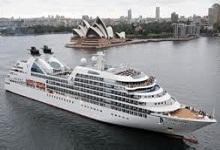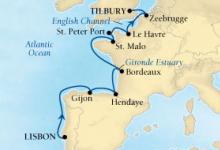Recently Viewed Cruises
- Sojourn, Harbours of Western Europe ex Lisbon to TilburyAdd to favourites
- Azura, Canary Islands A311 ex Southampton ReturnAdd to favourites
- Adventure, Sampler Cruise ex Southampton ReturnAdd to favourites
- Plancius, Pelagic West Africa ex Praia (Cape Verde) to FunchalAdd to favourites
- Independence, Canaries & Spain Cruise ex Southampton ReturnAdd to favourites
- Catch up on Cruising: Latest cruise news in bite size
- Royal Caribbean International raises the bar
- Classy Astor fills gap in market
- Oceanic Discoverer
- Ab Fab Oosterdam
- Frequently Asked Questions
-
Sojourn, Harbours of Western Europe ex Lisbon to Tilbury
Nights 12 Ship Seabourn Sojourn Star Rating 
Departs Lisbon, Portugal Sailing 2013: 11 May Ports of Call Lisbon, Gijon, Hendaye, Bordeaux, St Malo, St. Peter Port, Le Havre, Zeebrugge, Tilbury Please enquire about this cruise for pricing.


12 Night Cruise sailing from Lisbon to Tilbury aboard Seabourn Sojourn.
The second of Seabourn's new class of ships, Seabourn Sojourn, debuted on June 6, 2010 in the middle of the River Thames in London. Seabourn Sojourn's godmother was the English fashion icon and actress Twiggy.
Like her sisters, Seabourn Sojourn enchants her guests with an array of public areas scaled to encourage a relaxed sociability. One of the most unusual features of Seabourn Sojourn and her sisters is Seabourn Square, an ingenious "living room" that replaces the traditional cruise ship lobby with a welcoming lounge filled with easy chairs, sofas and cocktail tables. An enclave in its center houses knowledgeable concierges discreetly seated at individual desks, ready to handle all sorts of business or give advice and information.
The ship's shops are conveniently located just off the Square and it has its own open terrace aft. The Spa at Seabourn is the largest on any ultra-luxury ship, 11,400 square feet encompassing indoor and outdoor space over two decks. A variety of open terraces are scattered over seven decks, offering places to gather with a few friends or spend an isolated hour with a book.
Seabourn Sojourn offers six whirlpools and two swimming pools, including the Pool Patio, with a pair of large whirlpool spas and a "beach" style pool, a casual Patio Grill and the Patio Bar. On the sun deck above sits Seabourn's popular open-air Sky Bar. High atop Deck 11 is a Sun Terrace with 36 tiered double sun beds. Just aft of that is The Retreat, with shuffleboard courts and a nine-hole putting green. The panoramic Observation Bar on Deck 10 offers 270? forward views over the sea. The Club is a lively spot for dancing before and after dinner, while the larger Grand Salon is used for dancing as well as lectures, production vocal shows, cabaret performances and classical recitals.
Highlights of this cruise:
Lisbon
The great period of "the Discoveries" accounted for phenomenal wealth brought back from India, Africa and Brazil by the great Portuguese navigators. Gold, jewels, ivory, porcelain and spices helped finance grand new buildings and impressive monuments in Lisbon, the country's capital city. As you sail up the Tagus River, be on deck to admire Lisbon's panorama and see some of the great monuments lining the river. Lisbon is one of Europe's smallest capital cities but considered by many visitors to be one of the most likeable. Spread over a string of seven hills, the city offers a variety of faces, including a refreshing no-frills simplicity reflected in the people as they go unhurriedly through their day enjoying a hearty and delicious cuisine accompanied by the country's excellent wines.
Bordeaux
Bordeaux is the starting point for many exciting excursions into the surrounding wine country. The patricians of Bordeaux have always been merchants and shipbuilders. Under the Romans the city had a flourishing trade with Spain and Britain. In 1154, as a part of the dowry of Eleanor of Aquitaine, it became English and remained so until 1453. In the 18th century, Bordeaux prospered from the slave trade, and later in commerce with French colonies in Africa. Since Roman times the quality of the region's vines and wines has been zealously maintained.
St Malo
Saint-Malo, known as the Corsaires city, is situated at the Cote d'Emeraude on the Rance River in the north-east of Brittany. The city's name stems from the Welsh Monk MacLow Saint-Malo. The city, which has been a seaward fortress since the end of the 17th century, had one of the most important ports in France. The mighty fortifications and ramparts were designed by Simon Garangeau, a disciple of the famous Vauban. Founded in the 6th century as a monastic settlement, the city retains much of its august, historic and dignified veneer. Saint-Malo is now a city of granite rebuilt after WWII to its original style and skyline. Nearby is the island monastery of Mont St. Michel, founded in 708. A focal point for tourists and the faithful alike, early pilgrims risked their lives crossing the treacherous mud flats to reach this site. Now a dam is needed to keep Mont St. Michel's flats from silting up.
Le Havre
Originally built in 1517 on the orders of King Francois I, Le Havre, (the Harbor) grew to become France's second busiest port. Prior to World War II, Le Havre was home port to many of the day's great luxury liners, including the France, the Normandie and Ile de France. Virtually destroyed by bombing raids during the war, the present city is perhaps most notable for being the vision of a single architect, Auguste Perret, during its reconstruction between 1946 and 1964. Two buildings of particular note are the stark Hotel de Ville and the towering church of St. Joseph, with its 99-meter bell tower. The Musee des Beaux-Arts, near the port, features a room devoted to the works of native son Raoul Duffy in addition to a fine collection of 19th and 20th-century French artists.
Tilbury
Located on the Thames River, London is the largest city in Europe, sprawling over more than 600 square miles. Unlike most European capitals, London has almost no grand boulevards, planned for display. The exception is the Mall, running from Admiralty Arch on Trafalgar Square to Buckingham Palace. It was specifically designed for heraldic processions and stately occasions and, in a typically British way, is surrounded by gardens and lined with spreading trees. Apart from this one extravagance, present-day London still largely reflects its medieval layout, a bewildering tangle of streets with its origin in the one square mile beside the Tower of London, known as 'The City.' London is an ancient city, wearing its 2,000 years of history with dignity. Though constantly undergoing renewal of some sort, the city carefully guards its reminders of its past. Alongside modern skyscrapers are the crumbling remnants of the city's Roman wall. Norman London is evident in William's White Tower and in the oldest stones and tombs of Westminster Abbey. A few medieval churches, The City's oldest pub and the timbered Elizabethan facade of Staple Inn recall London before the Great Fire of 1666. Stately Georgian squares of the 18th century survive in the fashionable West End, and the neo-Gothic style of the 19th century is common. The newest additions are gleaming glass and steel towers, which have begun to dominate the face, if not the character, of London. A riverside walk is sure to delight with such sights as the Tower Bridge, the Tower of London, the Houses of Parliament with Big Ben, Westminster Abbey and numerous others. There are indeed endless things to see and do, a fact substantiated by as many as 24 million visitors each year. But in the midst of all those millions, life goes on as it has for centuries. Whether your interests center on the past or the present, on the arts, on shopping, theater or architecture, London has it all. The city fully justifies Dr. Johnson's famous dictum that 'When a man is tired of London he is tired of life.'





